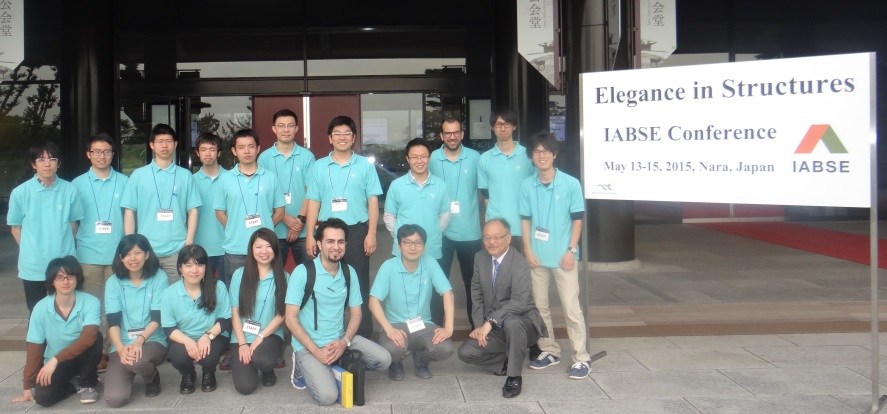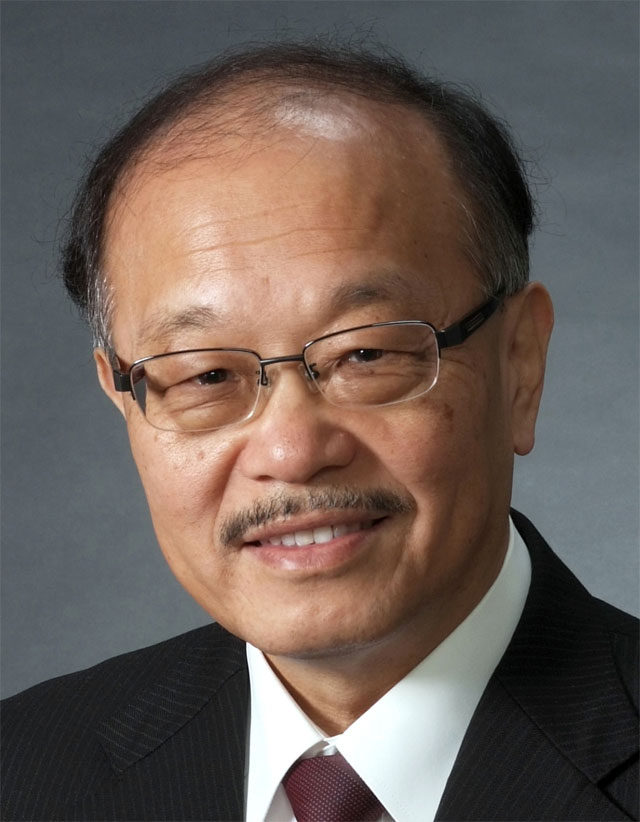Earthquake engineer wins top engineering honor

Masayoshi Nakashima ’81 Ph.D. (seated third from left at a U.S.-Japan student workshop in Kyoto in 2014) was recognized by the NAE for his pioneering work in hybrid simulation, a type of structural testing that combines physical experiments with numerical simulation.
Masayoshi Nakashima ’81 Ph.D. recently received one of the highest honors granted to engineers when he was inducted into the National Academy of Engineering as a foreign member. NAE cited him “for large-scale dynamic testing of buildings that has advanced structural earthquake engineering.”
A native of Japan, Nakashima completed his Ph.D. in civil engineering at Lehigh and then returned home. He joined the Disaster Prevention Research Institute (DPRI) of Kyoto University in 1992, was the Institute’s director from 2011 to 2013 and serves now as professor.
Nakashima has published more than 40 book chapters and nearly 200 technical articles. In 2014, he received the George W. Housner Medal from the Earthquake Engineering Research Institute for making a “profound impact on the advancement of earthquake engineering” and for “seminal work in the development of hybrid simulation.” Hybrid simulation is a type of structural testing that combines physical experiments with numerical simulation.
Nakashima has also received the Moisseiff Award and the Ernest E. Howard Award from the American Society of Civil Engineers and the Special Achievement Award from the American Institute of Steel Construction. He is a member of the Engineering Academy of Japan.
At Lehigh, Nakashima’s adviser was the late Le-Wu Lu, the Bruce G. Johnston Professor emeritus of structural engineering.
Kurt Pfitzer recently interviewed Nakashima about his education at Lehigh and his career as a structural engineer.
What is the main quality necessary to be a good researcher?
To me, it is “the courage to continue.” Sir Winston Churchill said, “Success is not final, failure is not fatal: it is the courage to continue that counts.” That is my favorite motto.
How did you hear about Lehigh and why did you choose to come here to do your Ph.D.?
It happened as a result of a solid friendship between Prof. Lu and my mentor at Kyoto University, the late Prof. Minoru Wakabayashi. In 1976, when Prof. Lu was looking for a research assistant to work on one of his projects, he met Prof. Wakabayashi at a conference. They talked and agreed to send one Kyoto student for this position. Prof. Wakabayashi encouraged me, saying, “Masayoshi, you always say you want to do something different.” Without hesitation, I said yes. Nine months later, I landed in Bethlehem.
What kind of reception did you receive from Lehigh?
As the arrangement was rather sudden, I was totally unprepared for life in an English-speaking environment. My TOEFL (Test of English as a Foreign Language) score, at the time I applied to Lehigh, was naturally low, but 40 years ago everything was more relaxed than now. Luckily, I was admitted to Lehigh because of the strong recommendations of Profs. Lu and Wakabayashi.
Life at Lehigh, both academically and socially, was tough the first year, but so many people, including teachers, administration members and classmates, offered very kind help that I was able to survive. I would like to express my deepest gratitude to Lehigh’s “friend-family system.” By coincidence, the host family assigned to me was the late Bob Johnson, professor of civil engineering, and his wife, Jane. They, particularly Jane, spent much time with me, helping me search for an apartment, open a bank account and get along in an English-speaking environment. Without her help, I would have never survived in the United States.
What kind of mentor and adviser was Le-Wu Lu?
Prof. Lu was a very intelligent individual on many issues spanning culture, life and academics. He was also very patient with his students, which was evidenced by his continuous support for my work, although I was not necessarily a most responsive student. Later when I myself became a university teacher, I learned that professors should be patient with their students.
Which other Lehigh faculty members had a positive influence on your career?
First and foremost was the late Prof. Lynn Beedle. He was very memorable. The course he taught to first-year graduate students was the least technical but most useful. It had to do with how to search literature, present materials and write reports. I still possess a binder with files of the handouts from this course, and I regularly transfer what I learned then to my own students.
What were some of the main lessons that you learned at Lehigh?
I learned the importance of communication and presentation. Japanese people value modesty, which is very important to the exercise of a good social life, but often times a Japanese person ends up keeping his mouth closed, not expressing his thoughts and opinions. Through interaction with my classmates and friends in Bethlehem, I learned the importance and usefulness of communication and presentation skills. I was originally a shy, taciturn individual. I’ve become talkative in public gatherings, which is the result of Lehigh’s excellent education and training.
What kind of projects did you undertake at Lehigh?
My Ph.D. project was about the seismic response of 3D building frames. We looked into how the flexibility of floor slabs connecting individual frames would affect the distribution of seismic forces into the frames. I became engaged in large scale structural testing as well as finite element analysis of reinforced concrete structures.
The experience was unforgettable, because very well-trained and disciplined engineers and technicians working for Fritz Laboratory helped me implement the tests. Without their kind assistance, the test and eventually my thesis would have never come about. After 40 years, I still remember the names and faces of [the people] who gathered on the lab’s first floor every morning. I learned that all of them had retired many years ago and some of them went to heaven. I give my sincere appreciation to all of them. This experience influenced a great deal of my research life after I returned to Japan.
When did you begin your work with hybrid simulation? What inspired you to conceive of combining physical experiments with computer modeling?
I was exposed to this idea when I joined the Building Research Institute (BRI) of Japan after I returned from Lehigh. At that time, a large U.S.-Japan project on earthquake engineering was launched, and many prominent professors in both the U.S. and Japan met regularly in Japan. One of the subjects discussed was a type of quasi-static testing in displacement control, in which the controlled displacement is not specified a priori but created during the test in reference to the associated equations of motion. This was the origin of hybrid simulation. The idea had been invented a few years earlier by a group of Japanese researchers, but its real application was yet to come. The testing then was called pseudo-dynamic testing, not hybrid simulation.
I became interested in the subject and fortuitously was assigned to work on it. I was lucky since very few researchers in the world were working on these developments, but I was also unlucky since I had very few to consult with. I was able to publish a few papers on those subjects in the 1980s and early 1990s. Researchers in other countries began citing my old papers over the past decade.
How has hybrid simulation improved our ability to understand and predict the response of structures to earthquakes and other disasters?
Traditional quasi-static tests provide us with the experimental information regarding the capacity of structural members and systems. This forms the basis of our structural design, including seismic design. From time to time, we also like to acquire experimental data on how structures would respond to, and sustain damage during, large earthquakes. Hybrid simulation offers such opportunities without esoteric, expensive testing equipment. We can utilize the basic experimental facilities that many research institutions own, with minimum addition of computer control. One of my early papers, published in 1995 in the Journal of Earthquake Engineering and Structural Dynamics, was titled: “Pseudo Dynamic Testing Using Conventional Testing Devices.” It began with the statement that: “to implement pseudo dynamic testing, we only need an old static-jack and pump (for loading), an old dial gauge (to measure displacement), an old strain meter (to measure force), a pencil, and a calculator.” This is still true. The most successful test can be done with imagination and insight—not with the most advanced machines.
What is your impression of the work with hybrid simulation being done at Lehigh through the National Science Foundation’s NEES (George E. Brown Jr. Network for Earthquake Engineering Simulation) and NHERI (Natural Hazards Engineering Research Infrastructure) programs? How do you see hybrid simulation evolving in the future?
The [improvement] of this technology is indispensable. In this, Lehigh is absolutely the powerhouse. Quite a few groups in the world are competing to advance hybrid simulation. In my personal, candid opinion, Lehigh is the best among all. I say this because: 1) the tests implemented at Lehigh are always neat, elegant and professional; and 2) the test results are always attached to real-world structural engineering and are thereby very significant and useful for structural design and construction. I trust that such unique developments are a result of the Lehigh (and Fritz Lab) legacy, which…features an elegant combination of research and practice and a spirit that values experimentation.
Last but not least, I would like to express my sincere appreciation to two of my long-term friends, James Ricles and Richard Sause. I am 100-percent certain that the strong leadership of these two professors has been the major vehicle for the unique and much-appreciated development of hybrid simulation at Lehigh.
The proponents of resilient infrastructure say structures should not only protect people’s lives during a disaster but also withstand and rapidly recover from disasters. How close are we to achieving this goal?
In the past 20 years, Japan has experienced two very serious earthquake disasters: the 1995 Kobe and the 2011 Tohoku. The 1995 Kobe was characterized by a large, pulse-like new fault quake, the loss of 64,000 lives due to the collapse of residential houses (mainly made of wood), and huge damage but with the affected area being concentrated. The most significant lessons drawn from 1995 Kobe were naturally collapse prevention and life safety. Numerous efforts were made after the quake to improve the strength and ductility of our buildings and other infrastructural systems, like base-isolation and structural control. The government of Japan also deployed a nationwide network of seismographs (for the accurate prediction of shaking) and a huge shaking table (named E-Defense) to verify technologies that are developed to enhance structural safety.
The 2011 Tohoku was different in many aspects. The shaking was severe in the vicinity of rupture faults, but the vast majority of buildings and other infrastructural systems not only avoided collapse but also sustained functionality, meaning life and business continued without interruption. This was in part because of our successful efforts after the 1995 Kobe and in part because of the nature of the shaking, which was not as impulsive as that of the 1995 Kobe. However, more than 16,000 lives were lost in the 2011 Tohoku, and this was because of the huge tsunami.
The extremely serious tsunami was generated by a huge rupture of earth along the Pacific coast that was not anticipated by modern science and technology. What happened was beyond our current understanding, and this leads to the term “resiliency.” Occasionally, nature brings us something very serious, which we do not want to confront. No matter how inconvenient it may be, we have to face it. The word “resiliency” means that we are destined to face inconvenience and damage and even loss of lives that we must try our best to minimize—no matter how infrequently they occur.
“Resiliency” shows the weakness of mankind while suggesting the importance of learning to cope with nature. First, we have to recognize that a huge earthquake, larger than what we consider in our seismic design, can take place. Second, we have to tolerate some damage from events that are beyond what we expect. Third, we must develop technologies to minimize inconvenience.
Japan’s structural engineers are looking seriously into how our structures would behave under shaking that is larger than what we consider in design, and how promptly we can detect and measure structural damage and functionality.
Photos courtesy of Masayoshi Nakashima
Posted on:






